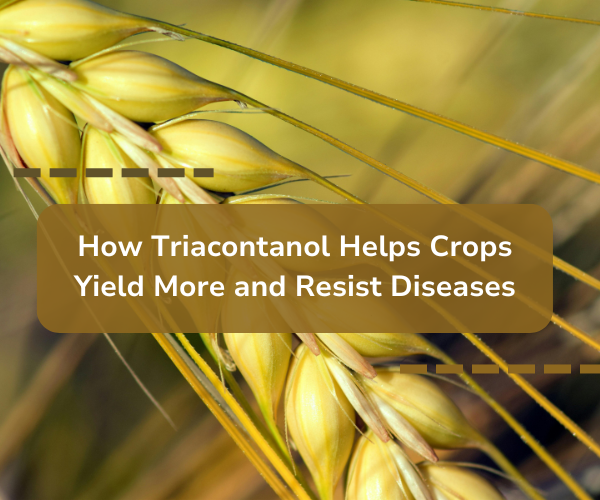Triacontanol (TA) is a natural, non-toxic, and highly effective plant growth regulator. It is widely found in plant waxes and insect cuticles. Studies show that even in small amounts (ppm level), it significantly boosts plant growth, improves fruit retention, and enhances stress resistance. Here’s how it works:
1. Improved Fruit Retention and Higher Yields
Fruit Trees
- Apples: Spraying a 0.1% triacontanol solution diluted 2000-5000 times during full bloom and early fruit set increases fruit retention by 20%. The fruit size becomes more uniform, and sweetness improves.
- Citrus: Applying a 2000-4000 times diluted solution during flowering and fruit expansion reduces fruit drop and enhances peel coloration.
- Jujube Trees: Spraying 2000-3000 times diluted TA solution during the physiological fruit drop phase increases fruit retention and significantly boosts yield.
Cash Crops
- Cotton: Spraying 1500-2000 times diluted TA during peak flowering reduces boll shedding and improves fiber length and strength.
- Peanuts: Applying 0.5mg/L TA during the seedling and early flowering stages increases filled pod rate by 10% and accelerates maturity by 5-7 days.
- Tea: Spraying during the one-bud-one-leaf stage increases tea polyphenol content and enhances quality.
2. Enhanced Stress Resistance
Drought and Cold Resistance
- Corn under drought conditions shows 30% longer roots and 20% more shoot dry weight after TA application.
- Wheat grown in saline-alkali soil exhibits greater plant height and more tillers.
- Winter wheat treated with TA has a lower frost damage index and higher survival rates.
Disease and Salt Tolerance
- Grapes: TA induces disease resistance enzymes, reducing downy mildew and powdery mildew incidence by 40%.
- Wheat in saline stress conditions shows better growth due to improved osmotic regulation.
3. Improved Crop Quality
Fruits and Vegetables
- Strawberries: TA increases sugar content by 15%, enhancing flavor.
- Chinese Cabbage: Spraying during the rosette and heading stages results in compact leaves and lower fiber content.
- Tomatoes: Applying TA during fruit expansion enhances color and increases vitamin C content.
Grains and Oilseeds
- Rapeseed: Spraying during full bloom boosts oil content and seed weight.
- Rice: TA application during grain filling reduces chalkiness and improves eating quality.
4. Application Methods and Precautions
Recommended Usage
- Foliar Spray:
- Fruit trees & vegetables: Dilute 1500-4000 times and spray 2-3 times during key growth stages (e.g., flowering, fruit setting).
- Grain crops: Dilute 1000-3000 times and apply during critical growth phases.
- Tank Mixing:
- Combining TA with 0.3% urea or humic acid enhances fruit retention.
- Mixing with growth regulators optimizes vegetative and reproductive growth balance.
Key Considerations
- Concentration Control: Excessive application may inhibit growth. For example, high TA concentration during the peanut pegging stage can cause excessive vegetative growth.
- Rainfastness: If rain occurs within 4-6 hours after spraying, reapply. Avoid mixing with acidic pesticides, as they may deactivate TA.
- Formulation Selection: Microemulsions have the highest efficacy, followed by emulsifiable concentrates. Choose products from reputable manufacturers.
By integrating triacontanol into crop management, farmers can achieve higher yields, better quality, and stronger stress resistance, ultimately increasing profitability and sustainability.


